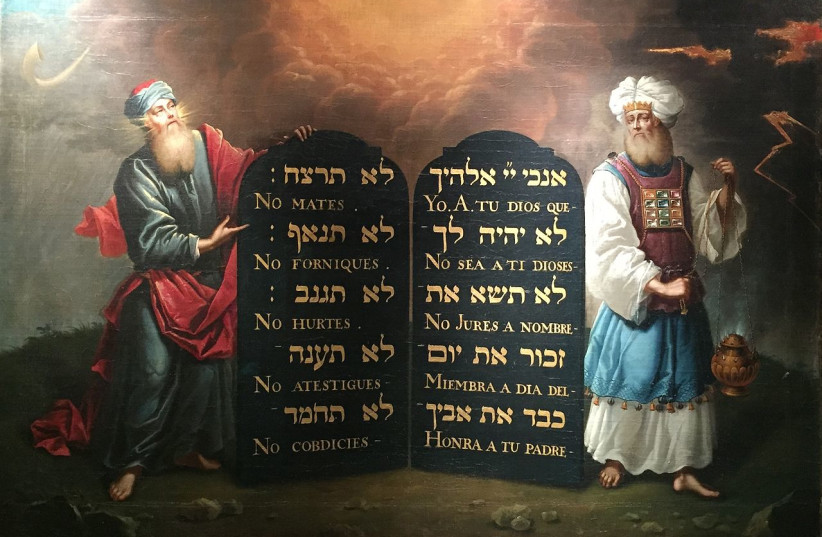“Moses and Aaron did as the Lord had commanded, and he raised the staff and struck the water that was in the Nile before the eyes of Pharaoh and before the eyes of his servants, and all the water that was in the Nile turned to blood. And the fish that were in the Nile died, and the Nile stank; the Egyptians could not drink water from the Nile, and there was blood throughout the entire land of Egypt. And the necromancers of Egypt did likewise with their secret arts, and Pharaoh’s heart was hardened, and he did not heed them, as the Lord had spoken” (Exodus 20-22).
In last week’s parsha, Shemot (Exodus), God had predicted that Pharaoh would not let the Israelites go “except by a mighty hand,” and had promised: “I will stretch out my hand, and smite Egypt with all my wonders which I shall do in their midst, and after that he will let you go” (Ex. 3:19-20). God not only knows in advance that Pharaoh’s heart will be hardened, He says, “I will harden his heart” (Ex. 4:21). The hardening of Pharaoh’s heart is part of God’s plan, not only for the children of Israel but for the world as well, so that all humankind will know that “I am the Lord, your God.”
Pharaoh personifies the human resistance to recognizing God’s sovereignty. Moses and Aaron begin by showing Pharaoh a rod that turns into a snake. When Pharaoh fails to be impressed by this miracle, the demonstrations of divine power that are the 10 plagues begin in earnest with the plague of blood.
The 10 plagues put an end to the Egyptian exile. The name Mitzrayim (Egypt) means “straits,” or “constriction”. Many commentators have said that the Egyptian exile stands for immersion in the world of materialism and impurity. In the ancient world, this took the form of idolatry – the worship of natural forces or phenomena as gods who supposedly control human existence. The Nile, whose yearly inundations watered the Egyptians’ crops and thus sustained their life, was one of the Egyptians’ chief gods. Hence, the first plague struck the Nile, turning its water into blood. (From a midrash which tells us that Pharaoh had a practice of bathing in the blood of Israelite infants, this plague also appears to be “measure for measure.”) One by one, in succeeding plagues, the powers of nature that the Egyptians worshiped would be dismantled, demonstrating that these powers were all subordinate to the God of Israel. Before the last plague – the death of the firstborn – God tells Moses, “I will execute judgments against all the gods of Egypt.”
The link between creation and the 10 plagues
Many commentators see a relation between the 10 plagues of Egypt and the “10 utterances” with which the world was created in the first chapter of Genesis. Whereas God’s 10 utterances established the order of the natural world, in which God’s power is hidden, the 10 plagues revealed God’s power, showing that the natural world exists only by God’s will. Thus the 10 plagues also prepared the way for the 10 Commandments, which establish an order that is above nature, the moral order, in which humans have free will.

Idolatry and immersion in the material world seem to be connected with human arrogance. According to one midrash, Pharaoh regarded himself as a god, and the reason he went down to the Nile, where Moses could meet him, was that he had to relieve himself like any mere mortal and did not want people to know this. In Ezekiel 29:3, God calls Pharaoh “the great crocodile who couches in the middle of his streams, who has said, ‘Mine is my Nile and I made it for myself’” (3-4). Today, we see that some of those who are immersed in materialism also have the belief that man can control the powers of nature and “play God.”
The world of material power-worship, which allows man to think himself a “god,” is paradoxically also the realm of slavery, of compulsion. Our sages tell us that “no slave ever escaped from Egypt.” In another “measure for measure,” Pharaoh, his heart hardened by God, acts as if under compulsion, unable to change course.
In Yoram Raanan’s painting Bathing Portent – an abstraction from which a portrait solidifies – Pharaoh appears as an imposing figure, powerfully crowned, immersed up to his nose in the river which begins turning to blood from the bottom up. Pharoah keeps going forward, even though the life source of Egypt is turned to blood and death. In the painting, we sense the hardened heart of Pharaoh: the angular lines of his face and nose hint at his headstrong stubbornness and inflexibility. As the water all around him turns to blood, his heart remains hard as he thinks himself a “god.” The blue and red shapes are powerful and energetic, tumultuous, momentous. Dark figures loom in the background at upper left – perhaps his advisers or magicians, or the “embassy of evil angels” (Ps. 78:49) who will carry out the work of demolition.
Today, the 10 plagues serve to remind us that we owe our existence as a nation to God, who is above nature and will prevail, despite the resistance of the world’s pharaohs. ■
Meira Raanan is the author of Art of Revelation: A Visual Encounter with the Jewish Bible, a commentary on the paintings by her husband, Yoram Raanan. She also teaches Jewish meditation. Esther Cameron is a poet, scholar, and essayist living in Jerusalem. She is editor-in-chief of The Deronda Review.
